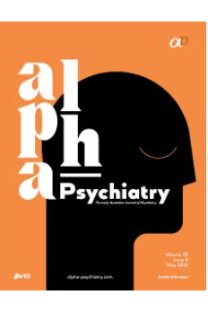The effect of Alcoholics Anonymous on abstinence duration in alcohol dependence: an example from Turkey
___
1.Alcoholics Anonymus, Turkey. Retrieved from http://www.adsizalkolikler.com/Tanitim.asp Access date: 12/07/20192.Kelly JF, Magill M, Stout RL. How do people re-cover from alcohol dependence? A systematic review of the research on mechanisms of behavior change in Alcoholics Anonymous. Addiction Research & Theory 2009; 17:236-259.
3.Mäkelä K, Kurube N, Arminen I, Bloomfield K, Eisenbach-Stangl I, Bergmark KH, et al. Alco-holics Anonymous as a mutual-help movement: A study in eight societies, New York, University of Wisconsin Press, Chapter 5, 1996, p.43-51.
4.Emrick CD. Alcoholics Anonymous: Affiliation pro-cesses and effectiveness as treatment. Alcohol Clin Exp Res 1987; 11:416-423.
5.Humphreys K, Moos RH. Reduced substance-abuse-related health care costs among voluntary participants in Alcoholics Anonymous. Psychiatric Serv 1996; 47:709-713.
6.McKellar J,Stewart E, Humphreys K. Alcoholics Anonymous involvement and positive alcohol-related outcomes: Cause, consequence, or just a correlate? A prospective 2-year study of 2,319 alcohol-dependent men. J Consult Clin Psychol 2003; 71:302.
7.Tonigan JS, Connors GJ, Miller WR. Participation and involvement in Alcoholics Anonymous. TF Babor, FK Del Boca (Eds.), International Re-search Monographs in the Addictions. Treatment Matching in Alcoholism. New York, NY: Cam-bridge University Press, 2003, pp.184-204.
8.Republic of Turkey, Ministry of Health, General Directorate of Health Investments. Retrieved from https://sygm.saglik.gov.tr/TR,32548/amatem-ve-cematem-projeleri.html.Updatedate:12/11/2018. Access date: 12/07/2019.
9.Hintze J. NCSS 2007. NCSS, LLC. Kaysville, Utah, 2007.
10.Modi L, Gedam SR, Shivji IA, Babar V, Patil PS. Comparison of total self-stigma between schizo-phrenia and alcohol dependence patients.Int J High Risk Behav Addict 2018; 7:1043.
11.da Silveira PS, de Tostes JGA, Wan HT, Ronzani TM, Corrigan PW. Drugs and social context. The stigmatization of drug use as mechanism of legiti-mation of exclusion. Springer, 2018, pp.15-25.
12.Republic of Turkey, Turkish National Police, Counter Narcotics Department. Retrieved from http://www.narkotik.pol.tr/kurumlar/narkotik.pol.tr/Arsiv/TUBIM/Documents/2018%20TURKIYE%20UYUSTURUCU%20RAPORU.pdf, Access date: 26.08.2019.
13.Petit G, Luminet O, Maurage F, Tecco J, Lechantre S, Ferauge M, et al. Emotion regulation in alcohol dependence. Alcohol Clin Exp Res 2015; 39:2471-2479.
14. Carr H, Rigdon K, Price M, Fortner H, Herring A. Coping strategies for recovering alcoholics and addicts to prevent relapse. Papers & Publications Interdisciplinary Journal of Undergraduate Research, 2018, pp.4-5, Available at: http://works.bepress.com/heather-carr/1/
15.Keyes KM, Hasin DS. Socio-economic status and problemalcohol use: the positive relationship between income and the DSM-IV alcohol abuse diagnosis. Addiction 2008; 103:1120-1130.
16.Hingson R, Heeren T, Zakocs R, Winter M, Wechsler H. Age of first intoxication, heavy drink-ing, driving after drinking and risk of uninten-tional injury among US college students. Journal of Studies on Alcohol 2003; 64:23-31.
17.Tonigan JS, Pearson MR, Magill M, Hagler KJ. AA attendance and abstinence for dually diag-nosed patients: a meta‐analytic review. Addiction 2018; 113:1970-1981.
18.Yıldırım B, Engin E, Yıldırım S. Loneliness and effective factors in alcohol and drug dependence. Journal of Psychiatric Nursing 2011; 2:25-30.
19. Grant BF, Goldstein RB, Saha TD, Chou SP, Jung J, Zhang H, et al. Epidemiology of DSM-5 alcohol use disorder: results from the National Epidemio-logic Survey on Alcohol and Related Conditions III 2015; 72:757-766.
20.Pektas O, Mirsal H, Kalyoncu OA, Mirsal N, Beyazyurek M. Assessment of sober alcohol addicts with ''Group attitude scale''. Journal of Dependence 2001; 2:124-126. (In Turkish)
21.Moos RH, Moos BS. Treated and untreated alco-hol-use disorders: Course and predictors of remis-sion and relapse. Eval Rev 2007; 31:564-584.
22.Hayes SC, Bissett R, Roget N, Padilla M, Kohlen-berg BS, Fisher G, et al. The impact of acceptance and commitment training and multicultural training on the stigmatizing attitudes and professional burnout of substance abuse counselors. Behav Ther 2004; 35:821-835.
23.Talbot AL, Dorrian J, Chapman J. Using the Theory of Planned Behaviour to examine enrolled nursing students' intention to care for patients with alcohol dependence: A survey study. Nurse Educ Today 2015; 35:1054-1061.
24.Sener MM, Kucuksen K. The role of non-govern-mental organizations in rehabilitation of article-associated with substance addicts. J Hum Sci 2017; 14:486-495. (In Turkish)
25. Jung DC, May I. The Bill W.—Carl Jung Letters. 1963; 19:2. AA Grapevine Inc.
26.Kelly JF. Is Alcoholics Anonymous religious, spiri-tual, neither? Findings from 25 years of mecha-nisms of behavior change research. Addiction 2017; 112:929-936.
27. Kurtz E, White W. Recovery spirituality. Religions 2015; 6:58-81.
- ISSN: 1302-6631
- Yayın Aralığı: 6
- Başlangıç: 2000
- Yayıncı: -
Tıp fakültesi öğrencilerinde bağlanma biçimi ile madde kullanma eğilimi arasındaki ilişki
Ferdi KÖŞGER, Ali Ercan ALTINÖZ
Computational analysis of affective facial behavior in children with the specific learning disorder
Miraç Barış USTA, M. Z. Koray KARABEKİROĞLU
Duygu düzenleme eğitiminin duygu düzenlemebecerileri üzerindeki etkisinin incelenmesi*
Hatice Güneş ÖZHAN BAYKAN, Canan TANIDIR, Hilal DOKTUR, Zerrin ÖNAL, Esra KUTLU, Hasan ÖNAL, Münir Kerim KARAKAYA
Professional experiences of early career academic psychiatrists in Turkey:a qualitative study
Burçin ÇOLAK, Öykü MANÇE ÇALIŞIR, Müge ARTAR, Eşref Cem ATBAŞOĞLU
Okul öncesi dikkat eksikliği hiperaktivite bozukluğunda yürütücü işlevler
Duygu KAÇAMAK ÖĞÜT, Nazlı Burcu ÖZBARAN, Sezen Gökçen KÖSE, Hande KESİKÇİ
R. Hülya BİNGÖL ÇAĞLAYAN, Dilara DEMİRPENÇE SEÇİNTİ
Factors affecting treatment compliance in patients with substance use disorder under probation
Hanife YILMAZ ÇENGEL, S. Utku UZUN, Müge BOZKURT, E. Cüneyt EVREN
Obsesif kompulsif bozukluğu olan ergenlerin toplumsal becerilerinin değerlendirilmesi
